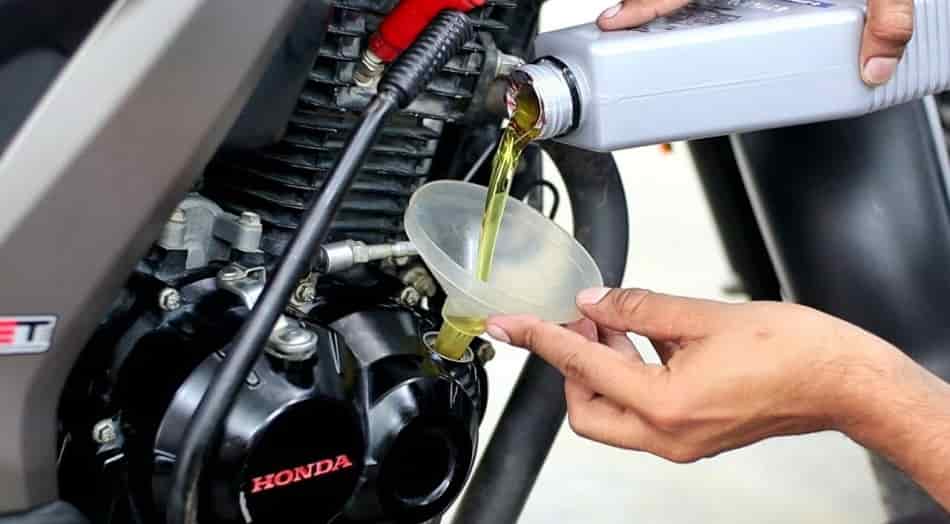If you’re not comfortable changing your own oil, be sure to take your motorcycle to a trusted mechanic for professional service. As a motorcycle owner, one of the most critical maintenance tasks you need to perform is changing your engine oil.
Motorbike or Motorcycle Engine Oil
The engine oil is the lifeblood of your motorcycle engine, lubricating and cooling its moving parts. But how often should you change your motorcycle engine oil? And how do you know when it’s time for a change? In this article, we’ll answer these questions and more. The engine oil is a vital component of any motorcycle, and it’s responsible for lubricating and protecting the engine’s moving parts.

Over time, the oil breaks down and becomes contaminated with dirt, debris, and other contaminants, reducing its ability to lubricate and protect the engine. This is why it’s crucial to change your motorcycle oil regularly.
How Engine Oil Works in Motorcycle?
The engine oil is responsible for lubricating the engine’s moving parts, reducing friction and wear. The oil also helps to cool the engine by absorbing heat from the moving parts and transferring it to the engine’s oil cooler. Additionally, the oil helps to clean the engine by picking up dirt, debris, and other contaminants and suspending them in the oil until it’s drained during an oil change.
Signs that You Need an Oil Change
There are several signs that you need to change your motorcycle oil. One of the most common signs is the oil’s color and consistency. Fresh oil is typically amber or light brown, while dirty oil is dark and sludgy. You can also check your oil level using the dipstick. If the oil level is low, it’s a sign that you need to add more oil or change the oil entirely.
Other signs that you need an oil change include engine noise, decreased performance, and a burning smell coming from the engine. If you notice any of these signs, it’s essential to get your motorcycle checked out by a professional.
Factors That Affect Oil Life
Several factors affect the life of your motorcycle engine oil, including:
- Frequency of use
- Type of motorcycle
- Type of oil used
- Environmental conditions
If you frequently use your motorcycle or ride in harsh environments, your oil will break down faster, requiring more frequent changes. Additionally, different types of motorcycles require different types of oil, and using the wrong oil can lead to engine damage or failure.
How Often Should You Change Your Motorcycle Oil?
The frequency of your motorcycle oil changes depends on several factors, such as your motorcycle’s make and model, your riding conditions, and the type of oil you use. As a general rule, most motorcycle manufacturers recommend changing your oil every 3,000 to 5,000 miles, or every six months to a year.
However, you should always refer to your motorcycle’s owner’s manual for specific oil change recommendations. Some motorcycles require more frequent oil changes, while others can go longer between changes.
How to Change Your Motorcycle Oil
Changing your motorcycle oil is a straightforward process that you can do at home with the right tools and a little bit of know-how. Here are the steps to change your motorcycle oil:
- Warm up your engine: Before changing your oil, warm up your engine to operating temperature by taking a short ride. Warm oil flows more easily, making it easier to drain.
- Gather your tools and supplies: You’ll need a few tools to change your oil, including an oil filter wrench, a drain pan, a funnel, and a new oil filter. You’ll also need fresh oil that meets your motorcycle’s specifications.
- Drain the oil: Place the drain pan under your motorcycle’s oil drain plug and remove the plug using a wrench. Let the oil drain completely into the pan.
- Replace the oil filter: Use your oil filter wrench to remove the old oil filter and replace it with a new one.
- Add fresh oil: Use a funnel to add fresh oil to your motorcycle’s oil tank. Check your owner’s manual for the correct amount of oil and the recommended viscosity.
- Check the oil level: After adding oil, let your motorcycle sit for a few minutes to allow the oil to settle. Then, use the dipstick to check the oil level. Add more oil if necessary.
- Dispose of the old oil: Once you’ve changed your oil, dispose of the old oil and filter properly. Most auto parts stores will accept used oil for recycling.
Choosing the Right Oil for Your Motorcycle
Choosing the right oil for your motorcycle is essential for maintaining your engine’s health and longevity. Different types of motorcycles require different types of oil, so it’s important to choose oil that meets your motorcycle’s specifications. Refer to your owner’s manual for the correct oil type and viscosity. When choosing motorcycle engine oil, it’s important to consider a few factors:
- Oil type: Motorcycles typically require either mineral-based or synthetic oil. Mineral oil is less expensive but needs to be changed more frequently, while synthetic oil is more expensive but provides better engine protection and can last longer.
- Viscosity: Viscosity refers to how easily the oil flows at different temperatures. Motorcycle engines operate at high temperatures, so it’s important to choose oil with the correct viscosity to ensure proper lubrication.
- Additives: Some oils include additives such as detergents, dispersants, and friction modifiers, which can improve engine performance and reduce wear.
Motorcycle Oil Change FAQs
How often should I change the oil on my new motorcycle?
Most new motorcycles require an oil change after the first 500 miles or so to remove any metal particles and contaminants left over from the manufacturing process. After that, you can follow your manufacturer’s recommended oil change intervals.
Can I use car oil in my motorcycle?
No, you should not use car oil in your motorcycle. Car oils are designed for engines with different needs than motorcycles, and using car oil can lead to engine damage or failure.
Should I change my oil before or after winter storage?
It’s a good idea to change your oil before storing your motorcycle for the winter. Fresh oil will help to protect your engine during the months of inactivity.
What happens if I don’t change my motorcycle oil on time?
If you don’t change your motorcycle oil on time, the oil will break down and become contaminated, reducing its ability to lubricate and protect your engine. Over time, this can lead to engine damage or failure.
How long does an oil change take on a motorcycle?
An oil change on a motorcycle typically takes around 30 minutes to an hour, depending on your level of experience and the tools you have available. It’s a simple process that can save you money and help to extend the life of your motorcycle engine.
Conclusion
Regularly changing your motorcycle engine oil is essential for maintaining your engine’s health and performance. By following your manufacturer’s recommended oil change intervals and using high-quality oil, you can ensure that your motorcycle stays running smoothly for years to come. If you’re not comfortable changing your own oil, be sure to take your motorcycle to a trusted mechanic for professional service.
